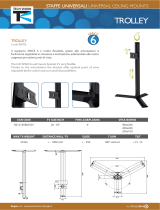
TOC
www.geniecompany.com 01-14
Table of Contents
Section 1 How to use this manual .................................................1.1
Section 2 Safety Information & Instructions ........................ 2.1-2.2
Section 3 Critical Installation Information ............................ 3.1-3.4
Section 4 Installation ............................................................. 4.1-4.10
Drawbar Assembly ...............................................................4.1-4.4
Drawbar Installation............................................................ 4.5-4.8
Connection to the Door ............................................................4.9
Clutch Adjustment ................................................................... 4.10
Section 5 Wiring ................................................................... 5.1-5.13
Safety Information/ Line Voltage Wiring .................... 5.1-5.2
Low Voltage Control Wiring ....................................................5.3
External Wire Diagram ...............................................................5.4
Wall Control ...................................................................................5.5
Interlock Switches .......................................................................5.6
Photocell Wiring ..........................................................................5.7
Sensing Edge Wiring ......................................................... 5.8-5.9
External Radio Installation .................................................. 5.10
Motor Connection/Safety Information .................. 5.11-5.13
Section 6 Operator Setup Procedures .................................. 6.1-6.10
Setting Close Direction ...............................................................6.2
Setting Braking Rate ................................................................... 6.3
Setting Travel Limits ...................................................................6.4
Setting Limit Overrun ..................................................................6.5
Monitored Reversing Devices
.............................................. 6.10
Setting Open & Close Modes ...................................................6.6
(Optional) Transmitter Programming....................................6.7
Setting Mid-Stop Limit ............................................................. 6.8
Section 7 Special Operational Features ..................................7.1-7.2
Operator Cycle Count ................................................................7.1
GDO & Display Firmware ..........................................................7.1
Operator Type...............................................................................7.2
Section 8 Troubleshooting ......................................................8.1-8.5
Display Operation .......................................................................8.1
Error Codes .............................................................................8.1-8.2
Run Codes ...............................................................................8.2-8.3
Troubleshooting Example using Codes ..............................8.3
LED Indicators ...............................................................................8.4
Safe-T-Beam® Troubleshooting Chart .................................8.5
Section 9 Service & Maintenance ................................................... 9.1
Preventive Maintenance Schedule .........................................9.1
Section 10
Appendixes ........................................................ 10.1-10.11
Appendix A ........................................................................10.1-10.7
Basic Operator Parts ...............................................................10.1
Basic Shafts Parts ......................................................................10.3
Basic Rail Parts ......................................................................10.4
Basic Carriage/Door Arms Parts.......................................10.5
Basic Electric Box Parts ......................................................10.6
Electric Box Layout ..............................................................10.7
Appendix B ..................................................................................10.8
Screw Terminal Assignments ..........................................10.8
Appendix C ...................................................................... 10.9-10.11
Run Codes ...............................................................................10.9
Error Codes ...............................................................10.10-10.11
Section 11 Warranty .......................................................................11.1
Motor Options ..........................................................................10.2
Resetting the MRT ...................................................................... 6.9























